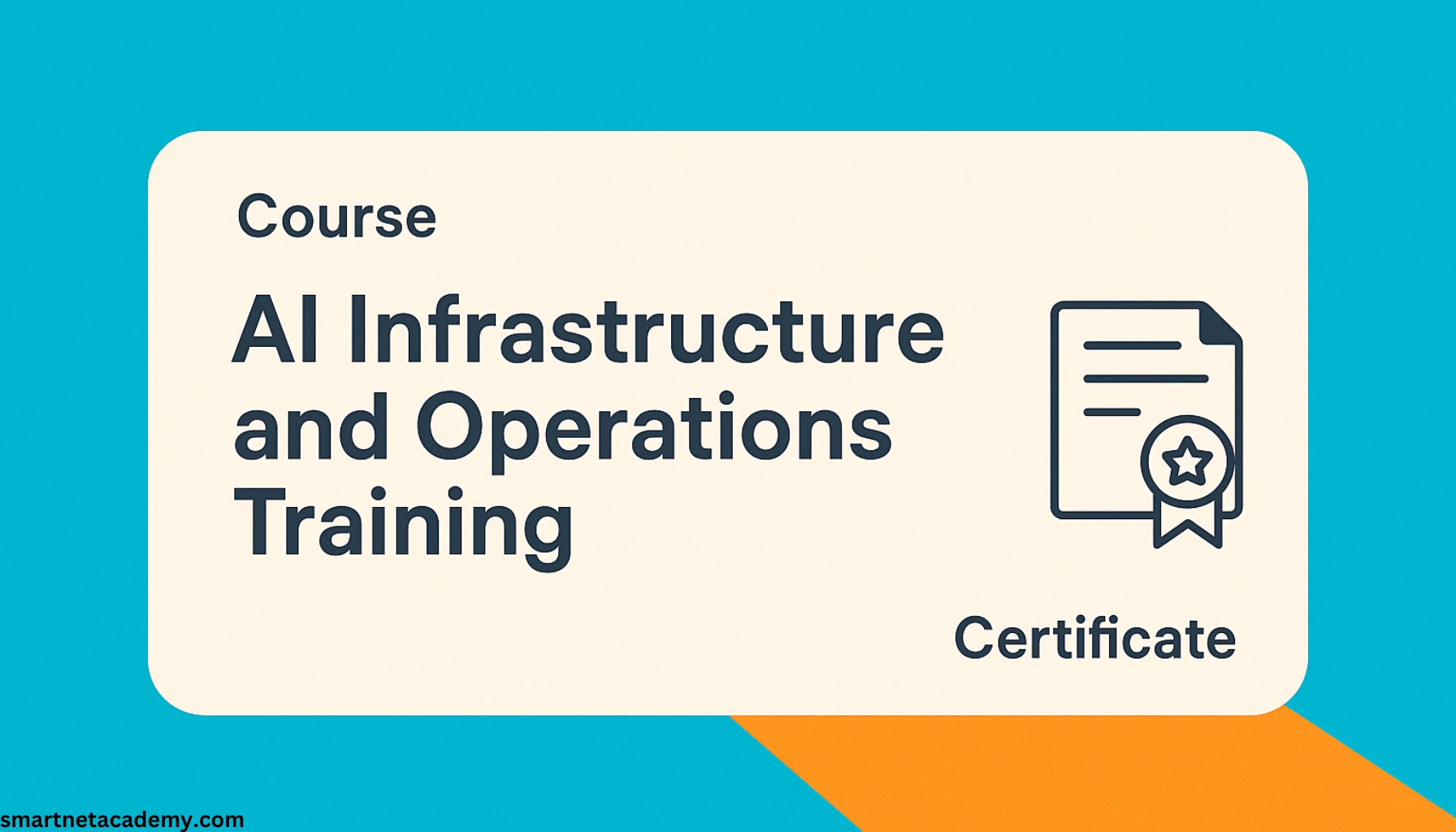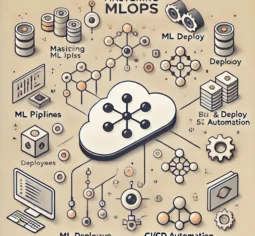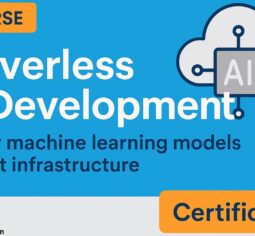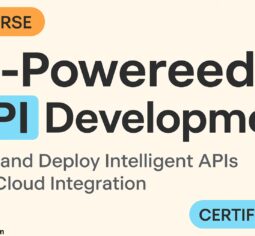Welcome to the AI Infrastructure and Operations Training, a comprehensive course offered by SmartNet Academy. This course is specifically designed for professionals looking to deepen their knowledge in the rapidly growing field of AI infrastructure. As AI continues to play an increasingly vital role in transforming industries, the demand for experts who can manage and optimize AI systems is higher than ever. Through this AI infrastructure course, you will gain the practical skills and theoretical knowledge necessary to build and manage scalable, efficient AI systems. Whether you are new to AI or looking to refine your skills, this course will provide you with the essential tools to excel in the world of AI infrastructure and operations.
In this AI infrastructure course, we explore how AI technologies, such as machine learning and deep learning, are integrated into infrastructure and operations. You will learn how to design, deploy, and manage AI systems across cloud, on-premises, and hybrid environments, ensuring optimal performance, security, and cost-efficiency. With practical exercises, industry case studies, and real-world applications, you will learn how AI infrastructure is applied in various industries, from finance to healthcare. By the end of the course, you will have a comprehensive understanding of the tools and methodologies used to deploy and manage AI technologies, positioning yourself as a leader in this innovative field.
Understanding the Core of AI Infrastructure 🌐
In this section, we will dive into the essential components that make up AI infrastructure, providing you with a solid foundation for understanding how AI systems are developed, deployed, and maintained. As one of the most vital aspects of AI, a robust infrastructure ensures smooth operation and scalability. Here, you will learn about the critical hardware, software, and networking essentials that form the backbone of AI technologies.
Hardware Essentials for AI Infrastructure 🖥️
AI systems rely heavily on specific hardware components designed to handle large datasets and complex computations. In this course, you’ll explore the essential hardware that supports AI operations, including:
-
Servers and Workstations: Understand the different types of servers and workstations required for running intensive AI computations, and how to choose the right hardware based on performance needs.
-
Graphics Processing Units (GPUs): Learn how GPUs are used to accelerate machine learning and deep learning tasks, and why they are crucial for running AI models efficiently.
-
Storage Devices: Get insights into high-performance storage systems, including SSDs and cloud-based storage, that handle the massive data involved in AI processes.
Software Essentials for AI Frameworks ⚙️
Building AI infrastructure requires more than just hardware. You need the right software frameworks and platforms to support and develop AI models. This section covers:
-
AI Frameworks: Explore popular AI frameworks like TensorFlow and PyTorch, which are used to develop machine learning and deep learning models for various AI applications.
-
Cloud-Based AI Solutions: Learn about cloud platforms such as AWS, Google Cloud, and Microsoft Azure that provide scalable AI solutions for businesses, allowing for easier deployment and management of AI models.
-
AI Development Tools: Discover the tools and libraries that are commonly used in the AI development pipeline, from data processing to model optimization.
Networking and Communication in AI Applications 🌐
A well-structured network is essential for the smooth operation of AI systems. This section will explain the role of networking in AI applications, including:
-
Data Processing and Communication: Understand how AI systems depend on real-time data communication between devices and servers, and how robust networks support high-speed data processing.
-
Scalability and Flexibility: Learn how to design scalable networks that can adapt to the growing demands of AI systems, ensuring efficient data flow and system responsiveness.
-
Cloud and Hybrid Connectivity: Delve into how cloud-based infrastructure and hybrid models allow AI systems to connect, store, and process data seamlessly across different platforms and environments.
By mastering these fundamental concepts, you’ll gain a deeper understanding of how to design, deploy, and maintain AI systems that function smoothly, making this AI infrastructure course an essential stepping stone for future AI practitioners and professionals.
Machine Learning and Deep Learning Deployment 🔍
As AI technologies continue to evolve, the deployment of machine learning (ML) and deep learning (DL) models has become a crucial step in integrating these systems into real-world applications. In this section of the AI infrastructure courses, we will guide you through the deployment process, providing you with the tools and techniques to set up environments, deploy models, and optimize their performance for diverse use cases.
Setting Up AI Environments for Model Development ⚙️
The foundation of successful machine learning and deep learning model deployment starts with setting up the right environment. This course will teach you how to:
-
Prepare Development Environments: Learn how to set up AI development environments using tools like Python, Jupyter Notebooks, and Integrated Development Environments (IDEs) like PyCharm to streamline model training and testing.
-
Data Preprocessing and Integration: Gain experience in preparing and processing data for training ML and DL models, understanding the importance of clean, well-structured data for optimal model performance.
-
AI Libraries and Frameworks: Explore libraries such as TensorFlow, PyTorch, and Keras that provide the necessary functionality to develop, train, and test AI models efficiently.
By the end of this section, you’ll have hands-on experience in preparing the environment for AI development, equipping you with the knowledge needed to deploy AI models on different platforms.
Deploying Machine Learning and Deep Learning Models 🚀
In this section, we will focus on the critical process of deploying machine learning (ML) and deep learning (DL) models, ensuring they perform efficiently across various infrastructures. As AI solutions become more integral to organizations, being able to deploy and scale these models is essential. This part of the course will provide you with practical insights into deployment methods, optimizing performance, and handling real-time applications.
Model Deployment Methods ⚙️
Understanding how to deploy AI models on different infrastructures is fundamental to their successful implementation. This course will introduce you to:
-
On-Premises Deployment: Learn how to deploy ML and DL models on on-premises servers, ensuring that you have full control over the infrastructure while optimizing hardware resources for model performance.
-
Cloud Deployment: Explore cloud environments such as AWS, Google Cloud, and Microsoft Azure, learning how to leverage the scalability and flexibility these platforms offer for deploying and managing large-scale AI models. You’ll also learn about services such as Google AI Platform, AWS Sagemaker, and Azure AI for easy deployment and model management.
-
Hybrid Systems: Gain a comprehensive understanding of hybrid deployment models that combine both on-premises and cloud-based solutions. This approach allows you to balance control, security, and scalability while making use of both local and remote computing resources.
By understanding these deployment methods, you’ll be able to choose the most suitable infrastructure for your models based on organizational needs, ensuring flexibility, cost-efficiency, and security.
Ensuring Scalability and Performance 📈
One of the most crucial aspects of deploying AI models is ensuring they can handle increasing data volumes and remain efficient. In this module, you will learn:
-
Scalability Techniques: Discover best practices for scaling AI models to handle large datasets and complex workloads. Learn about horizontal and vertical scaling, and how to distribute processing tasks across multiple servers and devices.
-
Optimizing for High-Performance Computing: Understand the importance of selecting the right hardware, including GPUs and TPUs, for performance-intensive applications. Learn how to leverage distributed computing systems to ensure models run efficiently across multiple devices.
-
Load Balancing and Redundancy: Delve into techniques like load balancing, which ensures that the workload is evenly distributed across computing resources to prevent bottlenecks. Learn how redundancy can be implemented to ensure continuous operation, even in case of hardware failure.
These techniques will allow you to deploy AI models that can scale as the data and infrastructure demands grow, ensuring consistent performance and reliability.
Real-Time Deployment and Optimization ⚡
For AI models to be truly valuable, they need to operate in real-time. In this section, you will explore:
-
Real-Time Applications: Learn how to deploy ML and DL models for applications requiring instant decision-making, such as predictive analytics, recommendation systems, and computer vision tasks. These models must process and analyze data quickly to deliver immediate results.
-
Latency Reduction: Discover methods to optimize models for low-latency operations, ensuring minimal delay in processing and providing real-time predictions. Learn how caching and edge computing techniques can be employed to reduce network latency and speed up inference times.
-
Model Optimization for Real-Time Processing: Explore optimization strategies that allow AI models to work efficiently in real-time environments. This includes techniques like model quantization, pruning, and compression, which reduce the computational load and improve inference speed while maintaining model accuracy.
By mastering real-time deployment, you’ll be able to ensure that your AI models can operate in fast-paced environments where immediate insights are required.
By the end of this section, you will have developed the expertise to deploy machine learning and deep learning models on various infrastructures, ensuring scalability, performance, and real-time operation. Whether deploying on-premises, in the cloud, or through hybrid systems, you’ll be able to make informed decisions about which deployment methods best suit your needs, and optimize AI models for real-time business applications. This knowledge will help you integrate AI seamlessly into production environments, enabling you to solve complex problems and drive efficiency in your organization.
Optimizing AI Models for Real-Time Applications ⚡
Optimizing AI models for real-time applications is essential for ensuring that they operate efficiently in fast-paced environments, delivering immediate results without compromising on accuracy or performance. In this section, we’ll explore practical techniques and strategies for optimizing machine learning and deep learning models, making them ready for deployment in real-world, real-time applications.
Model Optimization for Speed and Efficiency 🚀
Real-time applications demand fast and efficient AI models that can process large amounts of data quickly. In this section, you will learn:
-
Speed Optimization: Understand how to optimize models for faster inference times, ensuring quick decision-making. Techniques such as optimizing the model architecture, simplifying the neural network layers, and improving data pipeline efficiency will be covered.
-
Reducing Computational Costs: Learn how to minimize resource consumption while maintaining the accuracy of AI models. Techniques like early exit strategies, hardware-specific optimizations, and reducing the precision of computations will help lower energy and computation costs, making your models more efficient.
-
Balancing Speed and Accuracy: Discover how to fine-tune the trade-off between model accuracy and inference speed. Techniques such as hyperparameter tuning and regularization will ensure your models operate swiftly without sacrificing their performance.
By mastering these optimization techniques, you’ll be equipped to deploy AI models that provide high performance in real-time environments, ensuring that AI solutions are efficient and reliable.
Deployment Optimization Techniques for Leaner Models 🔧
Once you have a model that works well in theory, it’s time to optimize it for deployment. In this section, you will learn techniques to make your models more efficient and scalable for real-time environments:
-
Pruning: Learn how pruning can help remove redundant nodes or layers in a neural network, effectively reducing the model size and improving computational speed without sacrificing performance.
-
Quantization: Understand how to reduce the precision of weights and activations, converting 32-bit floating-point models into smaller formats (such as 8-bit integers) for faster and more efficient deployment.
-
Model Compression: Discover how compressing models into smaller versions can help reduce memory requirements and speed up the deployment process. Techniques like weight sharing, matrix factorization, and distillation will be explored to make your models leaner and more efficient.
These deployment optimization techniques will ensure that your AI models are ready to run in production, delivering real-time performance while maintaining their effectiveness.
Distributed and Parallel Computing for Large-Scale Models 🌐
When working with large-scale AI models, especially in real-time applications, managing performance across multiple machines or processors is key. This section will introduce you to distributed and parallel computing methods to handle complex workloads:
-
Distributed Computing: Learn how to distribute AI workloads across multiple servers or GPUs to reduce processing time. Techniques such as data parallelism, model parallelism, and task parallelism will be explored to handle large datasets and training jobs efficiently.
-
Parallel Processing for Real-Time AI: Understand how to set up parallel processing for AI inference, allowing multiple operations to run simultaneously, enhancing the speed and scalability of AI applications.
-
Cloud and Edge Computing: Explore how AI can be optimized using cloud and edge computing platforms. You’ll learn how to use cloud computing services (AWS, Google Cloud, Microsoft Azure) for scalability and edge computing for faster local processing, reducing latency in real-time applications.
These advanced techniques will enable you to optimize AI models for large-scale applications, ensuring that even complex AI systems can perform effectively in real-time environments.
Real-World Applications of Optimized AI Models 🌍
The techniques covered in this section will help you apply AI optimizations in real-world scenarios. For instance, AI models optimized for speed and efficiency are critical in applications like:
-
Predictive Analytics: AI models that provide real-time predictions in fields like finance, marketing, and healthcare need to process large datasets quickly to be valuable.
-
Recommendation Systems: In e-commerce and streaming services, optimized AI models ensure fast and personalized recommendations.
-
Computer Vision: Real-time image processing for autonomous vehicles or facial recognition systems relies on highly optimized models to function accurately and instantly.
By the end of this section, you’ll have the skills and knowledge to deploy and optimize AI models in various real-time scenarios, ensuring they meet the performance and scalability requirements of modern applications. Whether you’re working with predictive models, recommendation engines, or computer vision systems, you’ll be prepared to contribute to the success of AI projects by optimizing models for real-time efficiency.
Optimizing AI models for real-time applications is a critical skill for deploying AI solutions that can handle the demands of modern business environments. Through this section, you’ll learn how to enhance your models for speed, efficiency, and scalability, ensuring they perform well under real-world conditions. From model optimization and pruning to distributed computing and real-time deployment, these skills will prepare you to integrate AI into production environments successfully, contributing to more responsive, intelligent systems that drive business innovation.
Cloud Computing and AI Integration ☁️
In today’s evolving technological landscape, cloud computing is crucial for scaling AI applications and improving performance. As AI infrastructure continues to advance, cloud technologies provide businesses with the flexibility and scalability needed to handle complex AI workloads efficiently. This section of the course will focus on how to integrate cloud computing with AI to maximize the potential of your AI systems, reduce operational costs, and streamline workflows.
Cloud-Based AI Solutions 🌐
Cloud computing enables businesses to scale their AI systems without significant investments in physical infrastructure. By utilizing cloud platforms like Amazon Web Services (AWS), Microsoft Azure, and Google Cloud, businesses can store vast amounts of data and run advanced AI models with high availability and flexibility. In this section, you will learn:
-
Scalable AI Solutions: Understand how cloud computing allows businesses to scale their AI solutions to handle large datasets and complex algorithms.
-
Cost-Efficiency: Discover how leveraging the cloud can reduce costs by eliminating the need for expensive hardware investments and allowing businesses to pay for only what they use.
-
Elastic Computing Resources: Learn how cloud providers offer elastic resources, such as virtual machines and GPUs, that scale with the demands of AI workloads, allowing for efficient model training and deployment.
By the end of this section, you will understand how to design and deploy cloud-based AI systems, making it easier to expand your AI infrastructure while keeping costs manageable.
Hybrid Cloud and Edge Computing ⚙️
With the growing demand for faster, real-time processing, hybrid cloud and edge computing have become vital components of AI infrastructure. These technologies allow for processing data closer to the source, reducing latency and ensuring that AI systems run efficiently. This section will explore:
-
Hybrid Cloud Models: Learn how hybrid cloud solutions combine private and public cloud resources to give businesses flexibility in managing their AI workloads. Hybrid cloud allows organizations to keep sensitive data on-premise while leveraging the scalability of the public cloud for less critical tasks.
-
Edge Computing: Discover how edge computing enables AI systems to process data locally, on the edge of the network, closer to where the data is generated. This reduces latency and bandwidth usage, allowing for faster decision-making in real-time applications such as autonomous vehicles, IoT devices, and smart cities.
-
Optimizing Real-Time Applications: Understand how hybrid cloud and edge computing work together to support real-time AI applications. Learn how edge devices collect and process data while communicating with the cloud for advanced analytics and decision support.
By the end of this section, you will be able to implement hybrid cloud and edge computing strategies that optimize AI performance and enable real-time data processing.
Data Storage and Management in the Cloud 💾
Data storage and management are fundamental to the performance of AI systems, as they rely on vast datasets to train, test, and deploy models. This section covers various cloud-based data storage solutions and their integration with AI systems:
-
Cloud Storage Solutions: Learn about cloud-based storage services like Amazon S3, Google Cloud Storage, and Azure Blob Storage, which provide reliable and scalable data storage for AI models and datasets.
-
Data Access and Retrieval: Explore how data is organized, stored, and retrieved in the cloud, and how this integration supports AI workflows by ensuring quick and easy access to the data required for model training and inference.
-
Data Management Best Practices: Understand the importance of organizing data in a way that supports AI workloads, including the use of data lakes, databases, and data warehouses in the cloud.
This section will ensure that you are well-versed in the tools and best practices for managing large-scale AI data in the cloud, enabling you to develop systems that are not only efficient but also scalable.
Integration of Cloud Computing with AI Systems 🔗
Integrating AI with cloud computing infrastructure allows businesses to take full advantage of the power and scalability of the cloud. In this course, you will learn how to deploy AI solutions on cloud platforms and how to ensure seamless interaction between AI models and cloud infrastructure. Key points include:
-
Cloud AI Services: Discover how major cloud providers offer AI services, such as machine learning, natural language processing, and vision services, that are pre-configured and optimized for integration with cloud-based infrastructure.
-
Deploying AI Models in the Cloud: Learn how to deploy AI models onto the cloud, ensuring that they are scalable and easily accessible. This section covers the process of integrating AI models with cloud-based systems for real-time analysis and decision-making.
-
AI and Cloud Security: Understand the security implications of deploying AI systems in the cloud and explore best practices for safeguarding sensitive data and models.
By the end of this section, you will have the knowledge and skills to successfully implement AI infrastructure using cloud computing technologies. You will be able to design, deploy, and optimize AI models in cloud environments, ensuring scalability, performance, and cost-efficiency. Whether you are deploying AI on-premises, in the cloud, or using hybrid solutions, you will be equipped to maximize the power of cloud computing to support AI-driven business solutions. This practical knowledge is vital for anyone looking to work with AI infrastructure in real-world scenarios, ensuring that your organization can leverage cloud technologies to build scalable, high-performance AI systems.
Incorporating cloud computing into AI infrastructure is key to unlocking the full potential of AI systems, and with the knowledge gained from this course, you will be prepared to lead AI initiatives in various industries. Whether you’re optimizing real-time data processing, managing large datasets, or scaling AI applications, this course will help you build the necessary expertise to succeed in AI infrastructure roles.
Real-World Applications of AI Infrastructure in Industries 🏥💻
AI infrastructure is revolutionizing industries across the globe by providing powerful tools to streamline operations, improve decision-making, and drive innovation. In this section, we will dive into specific real-world applications and case studies from key industries that have successfully integrated AI into their infrastructure. Understanding how AI is deployed in these industries will help you visualize its transformative potential and gain practical insights for your own AI projects.
AI in Healthcare: Transforming Patient Care and Diagnostics 🏥
Healthcare is one of the most prominent sectors benefiting from AI infrastructure. With AI-powered tools integrated into the healthcare infrastructure, providers are enhancing patient care and operational efficiency. In this section, you will learn about the following AI applications:
-
Real-Time Diagnostics: Explore how AI algorithms are used to analyze medical imaging data (e.g., X-rays, MRIs, and CT scans) to detect diseases such as cancer, heart disease, and neurological conditions with greater speed and accuracy.
-
Personalized Medicine: Learn how AI-driven insights help physicians tailor treatments to individual patients by analyzing their medical history, genetics, and other factors, resulting in more effective and customized healthcare plans.
-
Predictive Healthcare Analytics: Discover how predictive models are used to forecast disease outbreaks, predict patient outcomes, and optimize hospital resource allocation, improving patient care and reducing operational costs.
By studying healthcare-specific use cases, you will understand the role of AI infrastructure in creating a more efficient, personalized, and responsive healthcare system. These applications are also improving the accuracy of diagnoses, enhancing treatment options, and reducing human error, all of which contribute to better patient outcomes.
AI in Finance: Optimizing Risk Management and Fraud Detection 💵
The financial sector is leveraging AI infrastructure to enhance decision-making, streamline operations, and ensure security. AI models deployed on financial institutions’ infrastructure are being used to optimize risk management, fraud detection, and customer service. Key AI applications in finance include:
-
Risk Management and Credit Scoring: Learn how financial institutions are using machine learning models to predict credit risk, assess loan eligibility, and provide more accurate credit scoring based on historical data and market trends.
-
Fraud Detection and Prevention: Discover how AI-powered fraud detection systems are being deployed to identify and mitigate fraudulent activities by analyzing transaction patterns in real-time. These systems improve security by detecting anomalies and suspicious behaviors quickly.
-
Customer Service Chatbots: Explore how AI-driven chatbots and virtual assistants are improving customer service in the financial industry by handling inquiries, processing transactions, and offering personalized financial advice.
These real-world applications demonstrate how AI infrastructure is playing a pivotal role in enhancing financial services, reducing risks, improving security, and driving customer satisfaction.
AI in E-Commerce: Enhancing Customer Experiences and Operational Efficiency 🛒
E-commerce companies are adopting AI infrastructure to optimize various aspects of their business, from customer experience to supply chain management. In this section, you will learn how AI infrastructure is being leveraged in the e-commerce sector:
-
Personalized Customer Experiences: Understand how AI algorithms are used to analyze customer behavior, preferences, and purchasing history to provide personalized recommendations, leading to increased customer satisfaction and higher conversion rates.
-
Inventory Management: Learn how AI is helping e-commerce companies optimize inventory levels by predicting demand, improving stock management, and automating restocking processes, ensuring that products are always available when customers need them.
-
Supply Chain Optimization: Explore how AI tools are improving supply chain management by optimizing logistics, forecasting demand, and ensuring that products are delivered efficiently, reducing costs, and improving delivery times.
AI infrastructure in e-commerce is driving business growth by improving operational efficiency and customer satisfaction, allowing companies to scale rapidly while maintaining personalized, efficient services.
Best Practices for AI Deployment Across Industries
By examining the applications of AI infrastructure across different sectors, you will gain critical insights into the challenges and best practices for deploying AI technologies. Key takeaways from the case studies include:
-
Scalability and Flexibility: Understanding how to design AI infrastructure that scales with business growth while remaining flexible enough to accommodate evolving needs.
-
Data Security and Compliance: Ensuring that AI systems meet data protection regulations and maintaining data security across various industries, especially when handling sensitive customer or patient information.
-
Collaborative AI Models: Recognizing the importance of combining human expertise with AI-driven insights to achieve optimal results in decision-making and problem-solving.
By the end of this section, you will have a clear understanding of how AI infrastructure can be integrated into real-world applications across industries. You will also learn about the best practices for deploying and managing AI systems in a way that maximizes their potential while mitigating common challenges.
In summary, the study of AI infrastructure applications in healthcare, finance, and e-commerce will provide you with the knowledge to implement AI-driven solutions across a range of business environments. By understanding how AI is transforming industries and aligning with business objectives, you will be equipped to contribute to your organization’s AI-driven transformation and drive meaningful improvements.
The Future of AI Infrastructure and Emerging Trends 🔮
AI is one of the fastest-evolving fields in technology, and its infrastructure is continuously adapting to meet the growing demands of businesses and industries. Staying ahead of the curve in AI infrastructure is essential for both organizations and professionals looking to lead in this rapidly changing landscape. In this section, we will dive into some of the most exciting trends and technologies shaping the future of AI infrastructure. From specialized hardware to the rise of generative AI and the increasing role of AI in automation, you will learn how these innovations are influencing the way AI systems are developed, deployed, and optimized.
The Role of GPUs and Specialized Hardware in AI Advancements 🖥️💡
As AI models become more complex and require more computational power, the need for specialized hardware is growing. General-purpose CPUs are no longer sufficient to handle the massive computational requirements of AI algorithms, especially when it comes to deep learning and machine learning tasks. Graphics Processing Units (GPUs) and AI-specific hardware have become the backbone of AI infrastructure, offering significant performance improvements and energy efficiency.
-
GPUs for High-Performance Computing: GPUs are designed to handle parallel processing, which is ideal for training machine learning and deep learning models that involve processing large amounts of data. By accelerating computations, GPUs drastically reduce the time needed to train complex models and run inference tasks.
-
Specialized AI Hardware: In addition to GPUs, other specialized hardware like Tensor Processing Units (TPUs) and Field Programmable Gate Arrays (FPGAs) are gaining traction in AI infrastructure. These hardware solutions are optimized for specific AI workloads, offering enhanced efficiency and lower energy consumption.
-
Impact on AI Deployment: With the increasing reliance on GPUs and AI-specific hardware, organizations are able to scale AI solutions more effectively, accelerating innovation and making AI more accessible. This hardware plays a crucial role in advancing AI technologies, particularly in industries where large-scale computations are necessary, such as autonomous vehicles, healthcare diagnostics, and financial services.
By understanding how GPUs and other specialized hardware are transforming AI infrastructure, you will be better equipped to implement scalable AI systems that meet the demands of modern enterprises.
The Rise of Generative AI and Its Impact on Creative Industries 🎨🤖
Generative AI is one of the most exciting advancements in the field of artificial intelligence, revolutionizing creative industries such as art, design, music, and media production. Unlike traditional AI models that focus on solving specific problems, generative AI models create new content based on patterns learned from existing data.
-
Generative AI and Creativity: With the rise of tools like DALL-E, GPT-3, and other generative models, AI is now capable of creating original content, including images, text, music, and even video. These models have opened up new possibilities for content creation, allowing artists, designers, and content creators to harness AI as a co-creator.
-
Transforming Media and Entertainment: In the entertainment industry, generative AI is being used to create music, generate scripts, and even design virtual characters, pushing the boundaries of creativity and production speed. Artists and designers are using AI tools to enhance their work, automate repetitive tasks, and experiment with new styles and formats.
-
The Future of Content Creation: As generative AI continues to evolve, its potential for transforming the creative process will grow. With AI infrastructure supporting these models, creators will be able to focus on higher-level tasks while leaving repetitive, time-consuming work to AI tools. This shift is likely to disrupt traditional creative processes and usher in a new era of AI-powered artistry.
Generative AI’s role in creative industries highlights how AI is not just a tool for automation but also an enabler of creativity, allowing industries to explore new ideas and approaches.
AI Automation and Its Growing Role in Business Processes ⚙️🤖
AI’s integration into business processes is accelerating, automating routine tasks and enabling smarter, more efficient decision-making. In the future, AI-driven automation will become increasingly prevalent across all sectors, from finance to healthcare, retail, and beyond. This section will cover the trends in AI automation that are shaping the future of business operations.
-
Automation of Routine Tasks: AI tools are increasingly being used to automate repetitive tasks, such as data entry, customer support, and inventory management. This frees up human workers to focus on more strategic and creative endeavors while AI handles the mundane tasks.
-
Smarter Decision-Making: AI is also transforming decision-making by providing real-time insights, predictive analytics, and prescriptive recommendations. Machine learning models can analyze large datasets to identify patterns and trends, helping businesses make more informed decisions.
-
Robotic Process Automation (RPA): RPA, powered by AI, is streamlining business operations by automating workflows and processes that previously required manual intervention. From financial reporting to HR tasks, RPA is improving efficiency, reducing errors, and cutting costs.
-
AI for Competitive Advantage: As AI-driven automation becomes more widespread, organizations that adopt these technologies will be able to operate more efficiently, improve customer experiences, and maintain a competitive edge. The ability to leverage AI for automation will be a key differentiator for businesses in the future.
By exploring the growing role of AI in business automation, you will gain a deeper understanding of how AI infrastructure can optimize processes, reduce operational costs, and drive business success across industries.
Keeping Up with the Evolving AI Landscape 🔄🚀
As AI technologies evolve at a rapid pace, it’s essential to stay informed about the latest trends and innovations. New developments in machine learning, AI-powered tools, and computational technologies are continuously changing the way businesses approach AI implementation. Keeping up with these trends is critical for professionals looking to lead AI-driven initiatives.
-
Continuous Innovation: The AI field is constantly evolving, with new algorithms, frameworks, and tools emerging regularly. As a result, organizations must stay agile and adapt their AI strategies to take advantage of new advancements.
-
New Applications and Opportunities: From autonomous systems to AI-powered customer service, the potential applications of AI continue to expand. Staying updated on the latest trends allows businesses to identify new opportunities and leverage AI to gain a competitive advantage.
-
The Future of AI Infrastructure: The development of more powerful hardware, such as GPUs and specialized chips, is enabling more complex AI models to be deployed across industries. This will drive further innovation and open up new possibilities for AI-powered applications.
By keeping up with the evolving AI landscape, you will be prepared to take full advantage of the transformative potential of AI infrastructure and stay ahead in an increasingly competitive market.
Shaping the Future of AI Infrastructure 🔮
In this section, we’ve explored some of the most exciting trends in AI infrastructure, from the increasing role of GPUs and specialized hardware to the rise of generative AI and the growing prevalence of automation in business processes. As AI continues to evolve, the importance of robust, scalable infrastructure will only increase. Whether you’re deploying machine learning models, integrating cloud-based AI solutions, or optimizing performance in real-time applications, staying ahead of the curve is essential for anyone involved in AI infrastructure.
By understanding these emerging trends and how they are transforming industries, you’ll be better prepared to implement AI solutions that drive business success and innovation. The future of AI infrastructure is bright, and professionals who can harness its power will play a pivotal role in shaping the next generation of AI applications.
Hands-On Experience and Practical Skills 🛠️
This course is designed to ensure that you don’t just learn theoretical concepts but also gain the hands-on experience needed to excel in managing AI infrastructure. Through interactive lessons, practical exercises, and real-world case studies, you will bridge the gap between classroom learning and real-world application. By the end of the course, you will have the skills to deploy and optimize AI systems in cloud, hybrid, and on-premises environments.
Interactive Lessons for Real-World Application 💡
The AI Infrastructure and Operations course is built around interactive lessons that challenge you to apply what you’ve learned in real-world scenarios. You’ll engage with exercises that simulate industry-specific problems, allowing you to:
-
Solve complex AI infrastructure challenges as they arise in businesses today.
-
Work through case studies to understand the practical application of AI tools.
-
Get feedback from experts to improve your decision-making and technical skills.
These hands-on experiences will help you develop a deep understanding of how AI systems function and how to optimize them for operational excellence.
Deploying AI Frameworks like TensorFlow and PyTorch 🚀
One of the key components of this course is learning to deploy AI frameworks that power cutting-edge technologies. By working directly with popular frameworks like TensorFlow and PyTorch, you will gain direct experience in:
-
Building and training machine learning models: Learn to set up and train models with TensorFlow and PyTorch for different applications, such as image recognition and data analysis.
-
Model deployment: Master the techniques for deploying models in both cloud and on-premises environments, ensuring that your systems can scale and handle real-time data.
-
Optimizing models: Understand how to fine-tune machine learning models for better performance and efficiency using these frameworks, making them suitable for high-demand environments.
These tools are industry standards, and by gaining practical skills with them, you’ll position yourself as a highly qualified professional in AI infrastructure.
Optimizing AI Systems in Cloud, On-Premises, and Hybrid Environments ☁️💻
As businesses are increasingly adopting AI technologies, the need to deploy AI systems across multiple environments has grown. In this course, you will learn how to optimize AI infrastructure in various setups, including:
-
Cloud environments: Learn how to deploy AI models on cloud platforms like AWS, Google Cloud, and Microsoft Azure. Understand the benefits of cloud computing for scalability, cost-effectiveness, and ease of access.
-
On-premises environments: Discover how to deploy and optimize AI systems within your organization’s own infrastructure, ensuring that they meet specific performance and security needs.
-
Hybrid environments: Explore how hybrid cloud systems combine on-premises and cloud infrastructure, allowing for greater flexibility and resource optimization.
By understanding how to deploy AI solutions in different environments, you will be ready to meet the demands of any organization, ensuring that AI systems are scalable, secure, and performing optimally.
Mastering Practical AI Infrastructure Skills 💪
This course equips you with the practical skills to manage AI infrastructure effectively. You will learn how to:
-
Troubleshoot and optimize AI systems: Apply best practices to improve AI system performance, ensuring reliability and security.
-
Manage cross-platform deployment: Work with both on-premises and cloud environments, mastering the intricacies of each.
-
Implement monitoring tools: Learn to set up monitoring systems that track the performance of AI infrastructure, ensuring smooth operations and preventing downtime.
The hands-on projects and tools provided throughout the course will help you become proficient in the full spectrum of AI infrastructure, from model deployment to optimization, and everything in between.
By the end of this course, you’ll not only have a comprehensive understanding of AI infrastructure but also the practical skills to deploy, manage, and optimize AI systems in real-world applications, positioning you as an industry leader in AI infrastructure.
AI Infrastructure and Operations Certifications 📜
Upon successful completion of the AI Infrastructure and Operations Training course, offered by SmartNet Academy, you will receive a Certificate of Completion that recognizes your mastery in AI infrastructure and operations. This certification serves as a tangible validation of your skills, helping you establish yourself as an expert in the rapidly growing AI sector. It’s more than just a certificate—it’s a stepping stone to elevating your career in AI.
Boost Your Professional Profile 🚀
Obtaining a certification from SmartNet Academy will significantly enhance your professional profile. This certification will be a key asset to add to your resume, LinkedIn profile, and portfolio, making you stand out to potential employers. By demonstrating your competence in AI infrastructure and operations, you will showcase your ability to design, deploy, and optimize AI systems, an essential skill set in the tech industry today.
-
Showcase your technical prowess: Add the certification to your professional profiles to highlight your expertise.
-
Stand out from the competition: A SmartNet Academy certification sets you apart from other candidates in the competitive AI job market.
Open New Career Opportunities 🌟
The demand for AI expertise across industries is skyrocketing. With this certification, you’ll open doors to a wide range of career opportunities in AI infrastructure, operations, and project management. Employers are actively seeking individuals who can manage and optimize AI systems to improve operational efficiency and support business growth. Whether you’re looking to step into a new role, transition into AI-related positions, or climb the career ladder, this certification will give you the advantage.
-
Access high-demand roles: AI is transforming industries, and organizations are eager to hire professionals skilled in AI infrastructure and operations.
-
Advance in your career: As AI continues to grow, companies will value certified professionals who can navigate complex AI systems.
Gain Credibility and Confidence 💼
As the demand for AI infrastructure experts continues to rise, earning a certification from SmartNet Academy will lend you the credibility needed to succeed. It proves that you have the knowledge, skills, and hands-on experience necessary to lead AI initiatives in any industry. Moreover, this certification provides you with the confidence to take on more responsibility, such as managing AI projects, leading teams, and making critical decisions regarding AI infrastructure.
-
Gain trust from employers: The certification signals to employers that you have been trained by an accredited institution, which adds credibility to your skill set.
-
Empower your career: With the confidence to implement AI solutions, you can step up to leadership roles and tackle advanced AI projects.
A Gateway to Mastering AI Deployment and Management 💻
The AI Infrastructure and Operations Training certification is not just a piece of paper—it’s your gateway to mastering the deployment, management, and optimization of AI systems. This knowledge is crucial for leading AI-driven transformation projects in industries such as healthcare, finance, manufacturing, and beyond. The course prepares you to handle the complexities of AI infrastructure and operations, making you a valuable asset in organizations adopting AI technologies.
-
Transform business operations: Learn how to optimize AI systems to improve efficiency, reduce costs, and drive business growth.
-
Lead innovative AI projects: With your certification, you will be ready to take on high-level projects that have a significant impact on business outcomes.
The AI Infrastructure and Operations Training course offers you the opportunity to master AI systems, and this certification will solidify your role as a leader in AI infrastructure and operations, opening numerous doors for career advancement and innovation.
Join the AI Revolution at SmartNet Academy 🚀
Are you ready to propel your career into the future? The AI Infrastructure and Operations Training course at SmartNet Academy is your opportunity to master the cutting-edge technologies that are driving the next wave of AI innovations. As AI continues to reshape industries, it’s essential to stay ahead of the curve, and this course will provide you with the expertise you need to be a leader in the rapidly evolving AI space.
Learn from Industry Experts 🌟
When you enroll at SmartNet Academy, you’re learning from some of the most respected professionals in the field of AI. Our instructors are seasoned experts with real-world experience in AI infrastructure, operations, and implementation. You will gain invaluable insights from their extensive knowledge and practical experience, empowering you with the skills needed to manage and deploy AI systems across various industries.
-
Practical insights: Learn proven strategies and techniques used by top AI professionals.
-
Cutting-edge knowledge: Stay updated on the latest trends, tools, and best practices in AI infrastructure.
Gain Hands-On Experience 🛠️
At SmartNet Academy, we believe in learning by doing. This course provides hands-on opportunities to work with the latest AI tools and frameworks, giving you practical experience that can be directly applied to real-world scenarios. You’ll have the chance to work with industry-standard platforms, implement AI models, and optimize systems—equipping you with the experience and confidence to handle any AI infrastructure challenge.
-
Real-world projects: Get practical experience with tools like TensorFlow, PyTorch, and cloud-based AI solutions.
-
Hands-on learning: Develop a portfolio that showcases your AI expertise and sets you apart in the job market.
Position Yourself as a Leader in AI Infrastructure 🏆
As AI continues to transform industries, the need for skilled professionals in AI infrastructure is growing rapidly. By mastering the core principles of AI operations, from model deployment to real-time optimization, you will position yourself as a key player in the AI-driven future. Whether you’re looking to transition into a leadership role, enhance your current expertise, or take on high-level AI projects, this course will prepare you for the next step in your career.
Take the Next Step Towards an AI-Powered Career 🌍
Don’t miss out on the opportunity to be part of the AI revolution. By enrolling in the AI Infrastructure and Operations Training course, you’re not just learning the technology—you’re positioning yourself to be at the forefront of a transformative industry. SmartNet Academy will guide you every step of the way, ensuring you have the resources and support needed to succeed.
-
Future-ready skills: Master AI infrastructure and operations, making you indispensable in the digital age.
-
Comprehensive training: Learn everything from basic concepts to advanced techniques in AI deployment and management.
Join SmartNet Academy today and take the next step in your AI career. This course is your gateway to mastering AI infrastructure, becoming a leader in the field, and shaping the future of technology with confidence. Let us help you unlock the door to a world of endless possibilities in AI! 🌐








































